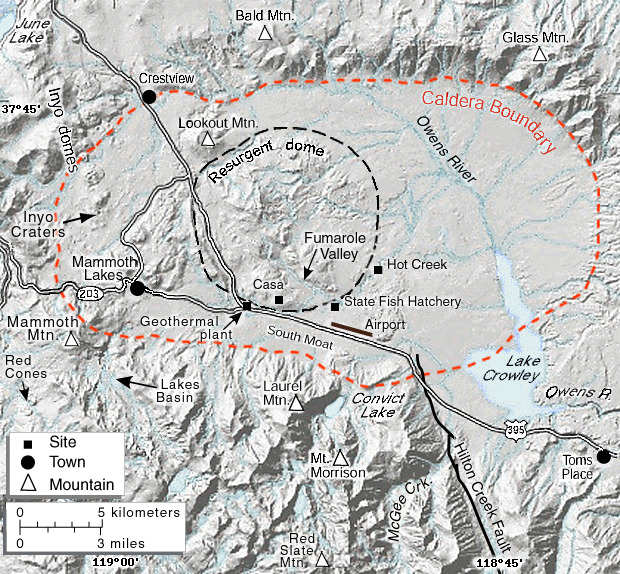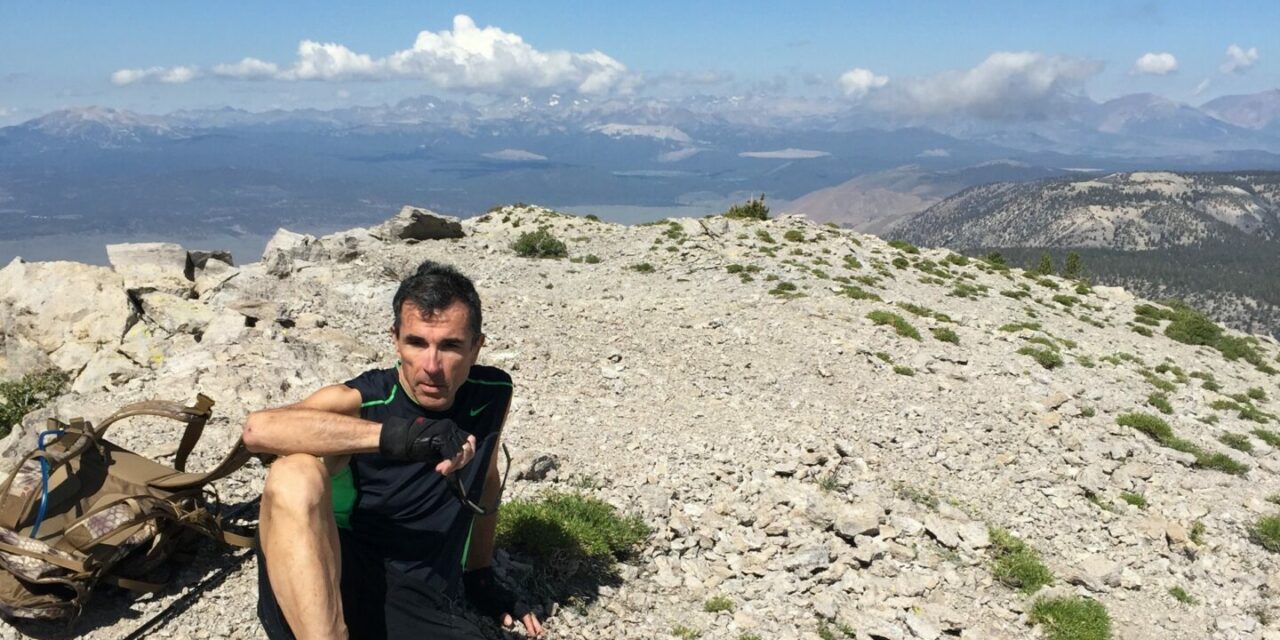It has given us Yosemite Valley, the fertile San Joaquin Valley & one of largest caldera volcanoes on the planet.
Climate change is coming.
And I say bring it on.
It’s not a cavalier attitude but a pragmatic viewpoint fashioned after hiking glacier carved peaks in Yosemite and sitting atop the 11,128-foot summit of Glass Mountain.
For those looking for something else to keep them awake from worry at night, Glass Mountain forms the northeast ridge of the Long Valley Caldera.
It is one of what the United States Geological Survey identifies as California’s four most active volcanoes that includes Mt. Shasta, Mt. Lassen, and Medicine Lake.
Unlike the other three that are in Northeast California, Glass Mountain is off Highway 120 due east of Manteca.
Ok, so its “way” due east beyond Yosemite’s Tioga Pass and Highway 395 some 20 miles southeast of Mono Lake as Highway 120 works its way toward its eastern terminus in Benton where it T-intersects into Highway 6.
The USGS defines active volcanoes as those that have erupted in the past 2,000 years. They also list two other potentially active volcanic areas — Clear Lake and Coso — within California’s boundaries.
The last volcanic eruption in California was from 1914 to 1917 at Mt. Lassen. Before that it was Mt. Shasta in 1786.
But those volcanoes are of a relatively minor concern compared to the Long Valley Caldera. At 20 miles long and 11 miles wide it is considered to be one of the world’s largest super volcanoes. Some experts say it has the potential for an explosion 1,000 times more powerful than Mount St. Helens’ eruption in 1980 that killed 57 people.
Part of the Long Valley Caldera is Mammoth Mountain located on its southwest rim.
It’s considered a young volcano built by numerous eruptions between 22,000 and 55,000 years ago. The USGS has determined during the past 5,000 years eruptions have occurred every 250 to 750 years in the Long Valley Caldera. The last was 250 years ago at Paoha Island in Mono Lake.
The USGS puts the odds of a volcanic eruption happening in the Long Valley Caldera at less than 1 percent a year. That is comparable to the odds for a magnitude 8.0 earthquake on the Richter scale such as the 1906 San Francisco tremblor along the San Andreas Fault.
The last time there was an eruption in Long Valley the ash cloud covered much of what is now the western United States and altered weather patterns. This is real climate change and it can’t be prevented.
Topping the list of super volcanoes is the Yellowstone Caldera beneath where Yellowstone National Park sits. When it was created, the volcanic explosion was 3,000 times greater than St. Helens in terms of ash and lava.
Depending upon whose list you are going by, volcanologists rank the Long Valley Caldera as No. 2 or No. 3. It is believed to have been created by an explosion 3,000 times more powerful than St. Helens based on ash and lava output. You certainly would have felt the shaking from that one if you had been in the Manteca area 760,000 years ago.
The most well-known example of a bowl created by a volcanic collapse is Crater Lake in Southern Oregon.
That said the United States Geological Society (USGS) lists Long Valley as one of three volcanoes in California that are considered very active. The others are Lassen Peak that last erupted in 1915 and Mt. Shasta that erupted in 1786.
The state has another four volcanoes including the Mono Inyo Craters just to the northwest of Long Valley that are considered “active” with another 30 plus that aren’t registering as being a threat.
Among those are the Sutter Buttes that pop up out of the middle of nowhere halfway up the Sacramento Valley between Colusa and Yuba City.
How active is Long Valley? During the seven days ending Feb. 16 the USGS recorded 24 earthquakes that were all 2.8 or less on the Richter scale.
While you might be alarmed by that, it can be put in perspective. During a typical month California records between 600 and 800 earthquakes, almost all which most humans can’t feel.
California is young geologically as underscored by the volcanoes.
Volcanologists aren’t sounding any alarm bells but consider this: Some form of volcanic eruption is expected every 100 years or so or about the same frequency of a 7.0 or higher quake along the San Andreas fault. The last quake of that magnitude — the 1906 San Francisco quake — registered 7.9. By comparison, the last Lassen eruption was in 1915.
In recent years there have been a number of quakes 3.0 or higher in the Long Valley Caldera. In the 1980s there was a swarm of quakes that ended up lifting half of the 200-square miles of the caldera by 10 inches. Then a decade later carbon monoxide gas created by underground lava escaped from the earth near Mammoth Mountain kills hundreds of trees.
All in all, 190,000 people in California live in areas considered to be volcano zones.
Hiking Glass Mountain
If you want to get an idea of the vastness of the Long Valley Caldera while still having both feet on the ground, then hiking to the summit of Glass Mountain is a must.
It’s 11,128-foot summit is the highest edge of the caldera.
The turnoff to Glass Mountain is roughly midway between Lee Vining and Benton where you can take advantage of a commercial resort built around hot springs.
The United States Forest Service roads are fairly well maintained and wide for the most part.
I hiked Glass Mountain 10 years ago with my nephew after ending a week of day hikes in the Eastern Sierra that ranged from 10 to 22 miles roundtrip. I tossed in Glass Mountain thinking I’d get just as good a workout than going for a run as I normally do on the day I pack up and leave from a base hotel either in Lone Pine, Bishop, June Lake, or Lee Vining.
I did think the 2.3-mile round trip hike might not meet my expectations of a workout given I normally jog about six miles on a travel day. Let’s just say I severely underestimated the workout you get gaining 1,865 feet in elevation in 1.3 miles. There is a reason the hike is rated “very strenuous.”
That said it was do-able on the way up by not trying to beat the clock. Most descriptions described it as a 3 to 5 hour hike depending upon your ability. We did it round trip is about 3½ hours.
I’d be remiss not to confess to slipping twice coming down on the steep scree covered trail even though I had hiking poles. The first time I got a little carried away with my pace. The second I got off the trail and — much to my nephew’s delight — was forced to slowly slide on my rear down an extremely steep part of the mountain for about 40 feet before I was able to rejoin the trail that has switched back below.
The hike is my favorite by far when it comes to the reward at the top.
The vista, thanks to being on what is the rim of a volcano more than 3,000 foot above the floor, was unlike any other. I’d say it was the best view looking toward the Eastern Sierra you’ll find along Highway 395 that you cross driving Highway 120 to the Glass Mountain access road.
Landmarks such as Mt. Dana in Yosemite, Mammoth Mountain, Tioga Canyon, and Mono Lake were easy to pick out. The fact I could lay on my stomach and look down 3,000 feet and soak in the fact I was on the edge of a super volcano gave me a unique perspective of where I live.
And, perhaps most important, it was the only peak outside of Death Valley I’ve been able to summit and return to the trailhead without passing another soul. The last visitors before us were 22 days prior based on the summit registry when a Boy Scout Troop out of Reno with 12 members tackled Glass Mountain. That’s my idea of solitude.
You could always drive across the caldera on Highway 395 but you honestly get no inkling of the amazing geological feature that is in the 209’s backyard just a relatively short drive east of Yosemite National Park.
It also makes you realize how great it is to be along the 152.6-mile ribbon of asphalt known as Highway 120 that takes you from the edge of the Delta, up through the Gold Country, into Yosemite National Park, within four miles of the most accessible 13,000 plus peak in California to hike, past the prehistoric Mono Lake, and by a super volcano.

Man can fiddle with the climate but it really doesn’t matter. San Francisco’s Ocean Beach didn’t exist 100,000 years ago nor did the Golden Gate for that matter. Rivers dumped into the ocean miles west of current day San Francisco and you could walk to the Farallon Islands.
The oceans have been rising — or in flux — for centuries upon centuries. Climate change is part of the geological forces that continue to shape the earth. Hastening major changes isn’t in mankind’s best interests but it’s also true we are powerless when all is said and done to stop it.
Climate change created the San Joaquin Valley’s fertile farmland that was once under the sea.
Without climate change California — as well as the rest of the world — as we know it would not exist.
If climate change is so bad, why do 4 million people each year come from all the corner of the globe to take in the sites carved by the advance — and then retreat — of massive glaciers in Yosemite National Park.
You cannot dispute that climate change is real. What is open to argument is whether man is impacting it one way or another as well as the bigger question — does it really matter in the end what we do?
This summer take a hike to North Dome. It’s 7,546-foot summit rises almost 3,500 feet straight up from Yosemite Valley’s floor. From there you get a clear view of climate change’s handiwork as you can see the glacier carved Half Dome, Cloud’s Rest, El Capitan’s Dawn Wall, and Glacier Point.
Then head east to Glass Mountain. Hiking to North Dome is a walk in the park compared to the quad busting steep ascent of Glass Mountain where the summit registry has gaps as long as 30 days during the hiking season of another human standing atop it.
From that lofty vantage point you can see much of what the mighty Long Valley Caldera is molding.
To try and stop climate change is not only impossible but it is a fool’s dream.
The great cities we have built on earth will disappear in time. Some will suffer a quick fate such as Pompeii located below Mount Vesuvius. Others will die a slow death like Venice.
An ocean that was once 10 miles or more east of San Francisco will surely retake Venice, large swaths of Florida as well as coastal cities like New York and San Francisco all in due time.
Again, it is foolish to speed up the process but at the same time it is arrogant to think you can stop it.
Climate change is here. Stop worrying and embrace it. Go take a hike.


